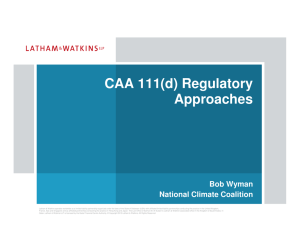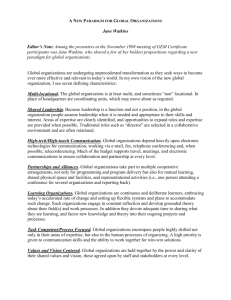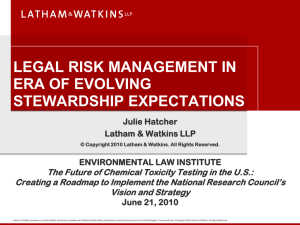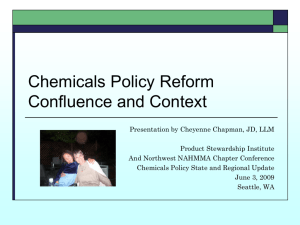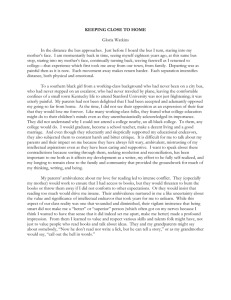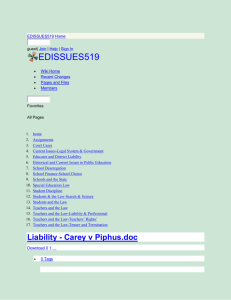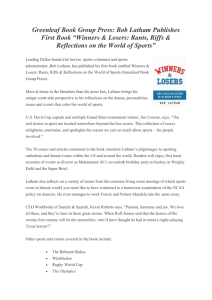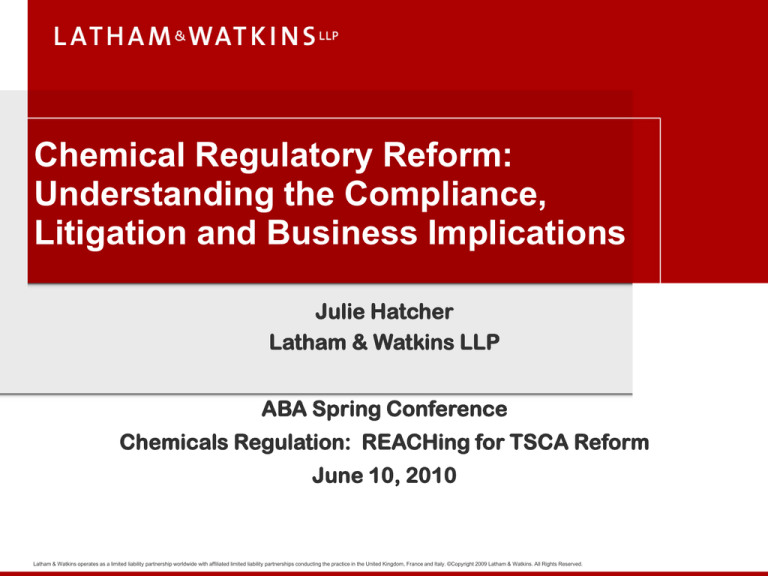
Chemical Regulatory Reform:
Understanding the Compliance,
Litigation and Business Implications
Julie Hatcher
Latham & Watkins LLP
ABA Spring Conference
Chemicals Regulation: REACHing for TSCA Reform
June 10, 2010
Latham & Watkins operates as a limited liability partnership worldwide with affiliated limited liability partnerships conducting the practice in the United Kingdom, France and Italy. ©Copyright 2009 Latham & Watkins. All Rights Reserved.
1
2
U.S. LEGAL
IMPLICATIONS OF
REACH
More of a Stewardship “Driver”
Than You Might Think???
Latham & Watkins operates as a limited liability partnership worldwide with affiliated limited liability partnerships conducting the practice in the United Kingdom, France and Italy. ©Copyright 2009 Latham & Watkins. All Rights Reserved.
Company-Driven Risk Decisions
Currently Being Made Under REACH
What additional testing is needed to support Registration?
Traditional Health Studies
Biomonitoring
Exposure Assessment
Nanomaterials
Emerging Science
E.g., Genomics
E.g., Low Dose
When is an Article subject to Registration or Notification due to:
“Intended to be released under normal or reasonably foreseeable conditions of
use” (Registration)
Contains SVHC and cannot exclude “exposure to humans or the environment
during normal or reasonably foreseeable conditions of use, including disposal”
(Notification)
4
Company-Driven Risk Decisions
Currently Being Made Under REACH
(continued)
Where Chemical Safety Report requirement applies. . .
When must Chemical Safety Report include Exposure Scenarios
and Risk Characterization because assessment indicates
substance qualifies as:
Does sufficient information exist for requisite human health and environmental
assessment?
Should one (or more than one) DNEC be calculated and with reference to what
endpoints?
What environmental spheres should PNECs be calculated for?
PBT;
vPvB; or
“(i) with dispersive or diffuse use(s) particularly where such substances are used
in consumer preparations or incorporated into consumer articles and (ii) for
which it is predicted . . . that they are likely to meet the [other Dangerous
Substance] classification criteria for any human health or environmental effects
endpoints under Directive 67/548/EEC”?
When must “safer alternative” to SVHC be identified in
Substitution Plan?
5
U.S. Regulatory Requirements Potentially
Triggered by Such Decisions
TSCA Section 8(e) “substantial risk” notification
Product-Related Disclosures
Federal Insecticide, Fungicide and Rodenticide Act
Federal Food, Drug and Cosmetics Act
Federal Hazardous Substance Act
Consumer Products Safety Act
Securities Disclosures
State Laws
E.g., Proposition 65
6
TSCA Section 8(e)
8(e) can be triggered
“Sliding scale” reporting trigger in EPA’s guidance
New information
Re-assessment of existing information
Requires qualitative judgments about (1) seriousness of the adverse
effect, and (2) fact or probability of effect’s occurrence
Possibility of such judgments being second-guessed later and in
hindsight by EPA through enforcement action
“Sliding Scale” Examples (see next page)
7
TSCA Section 8(e)
“Sliding Scale” Examples:
For substance subject to CSR exposure scenarios requirement as PBT or vPvB,
does potential exist for “widespread exposure” and “non-trivial adverse effect”
For substance subject to CSR exposure scenarios requirement as “likely to
meet” “dangerous substance” criteria for CMRs, does EPA already “know” of
information forming basis for this judgment
For substance subject to CSR exposure scenarios requirement as “likely to
meet” “dangerous substance” criteria for “very toxic to aquatic organisms”,
does evidence indicate “chemical has bioaccumulated to a pronounced degree
. . . or it is or could (based on use patterns) be widespread in environmental
media”
For substance where CSR exposure scenarios indicate potential for exposure in
excess of DNEL, is chemical associated with “non-trivial adverse” effect and
does potential exist for “widespread” or “significant” exposure
8
Securities Disclosure:
Regulation 5-K Item 303 (17 C.F.R. §
229.303)
“Describe any known trends or uncertainties that
have had or that the registrant reasonably expects
will have a material favorable or unfavorable impact
on net sales or revenues or income from continuing
operations. If the registrant knows of events that will
cause a material change in the relationship between
costs and revenues (such as known future increases
in costs of labor or materials or price increases or
inventory adjustments), the change in the
relationship shall be disclosed.”
9
Securities Disclosure:
Regulation 5-K Item 100 (17 C.F.R. §
229.101
(c) Narrative description of business.
...
(xii) Appropriate disclosure also shall be made as to the
material effects that compliance with Federal, State and local
provisions which have been enacted or adopted regulating the
discharge of materials into the environment, or otherwise
relating to the protection of the environment, may have upon
the capital expenditures, earnings and competitive position of
the registrant and its subsidiaries. The registrant shall disclose
any material estimated capital expenditures for environmental
control facilities for the remainder of its current fiscal year and
its succeeding fiscal year and for such further periods as the
registrant may deem materials.
10
Securities Disclosure:
Some Recent Developments
Some companies have mentioned REACH in
securities filings
Indicate could restrict ability to market certain products
Shareholder activists increasingly target chemical
risk management issues for disclosure resolutions,
using REACH as one focal point
E.g., Investor Environmental Health Network “Toxic Stock Syndrome:
How Corporate Financial Reports Fail to Apprise Investors of the Risks
of Product Recalls and Toxic Liabilities”
11
Additional Regulatory and
Stewardship Implications
New Chemicals Review
Risk Assessment
Changes in paradigms and approaches
Adjustment of health benchmarks by federal and state agencies
Biomonitoring
Corporate EHS Policies and Procedures
Deselection and Manufacturing phase-outs
E.g., Certain suppliers could discontinue or limit production due to
REACH regulatory burdens/health and safety considerations.
E.g., REACH Authorization required for SVHC to remain in EU
commerce ultimately may lead not only to restrictions in the EU, but to
deselection around the world as other countries -- and even some U.S.
states (e.g., California) -- look to REACH as a chemical regulatory
model
12
Liability Implications of
Company-Driven Risk Decisions
May constitute “admissions” by Company for litigation purposes
May serve as catalyst for litigation
_________________________________
“Toxic Tort”/Product Liability
E.g., Certain exposure scenarios raise risk concerns or have other legal
implications
E.g., Articles with SVHC where “exposure to humans or environment
during normal or reasonably foreseeable conditions of use” cannot be
“excluded”
E.g., Evolution of industry standard of care
E.g., Substitution plan process for high risk chemicals identifies “safer
alternatives”
NGO Litigation
E.g., Petitions/lawsuits around denial of petitions for agency action
E.g., Citizen’s Suits
13
Regulatory Findings Under REACH
REACH imposes various regulatory review standards
that -- in theory -- could have material impacts from
an evidentiary standpoint in the U.S. courts.
These standards, among others, include:
14
Regulatory Findings Under REACH
(continued)
ECHA finding that substance qualifies as a “SVHC”
Essentially entails finding that “there is scientific evidence of
probable serious effects to human health or the environment”
from the substance
ECHA setting for SVHC of:
“Derived No-Effect Level” (DNEL)
“Level of exposure to the substance above which humans should not
be exposed”
“Predicted No-Effect Concentration” (PNEC)
“Concentration of a substance below which adverse effects in the
environmental sphere of concern are not expected to occur”
15
Regulatory Findings Under REACH
(continued)
EHCA ruling (implemented through a European
Commission directive) that authorisation of each
SVHC should (or should not) occur under one of two
standards:
(1) "if the risk to human health or the environment from the use of a
substance arising from the intrinsic properties . . . is adequately
controlled . . . taking into account . . . all discharges, emissions and losses,
including risks arising from diffuse or dispersive uses known at the time
of the decision" or
(2) "if it is shown that socio-economic benefits outweigh the risk to
human health or the environment arising from the use of the substance
and if there are not suitable alternative substances or technologies."
16
Potential Evidentiary Impacts
EHCA decisions, being that of foreign agency, would not have
legally preemptive impact, but would be
Admissible under the “public records” exception to the hearsay rule (Fed. R.
Evid. 803(8)),
unless “sources of information” or “other circumstances” indicate that
particular decision is “untrustworthy” or “unreliable”
Even if admissible, evidentiary weight given to ECHA decision
would vary depending upon considerations, such as,
(i) whether process underlying decision reflects indicia of fairness and scientific
rigor;
(ii) whether decision is interim or final;
(iii) whether decision reflects an industry "standard"; and
(iv) whether decision has been repudiated or superseded by a U.S. federal or
state agency.
17
Implications of REACH for
Chemical Stewardship
REACH may have various impacts, including:
Targeting articles via SVHC provision
Creating U.S. regulatory disclosure obligations
Generating findings or evidence relevant to litigation (or that even could serve
as a catalyst for litigation)
REACH may fuel U.S. state initiatives in absence of new or
different federal chemical control action, including:
Highlighting risk issues not well-understood
Altering supply-chain relationships
Chemical bans
State risk levels for drinking water, groundwater and other media
Such initiatives will add to already existing burden and
pressures on industry fueled by public “right to know”/scientific
populism
18
THE TSCA REFORM
“WILD CARDS”
Latham & Watkins operates as a limited liability partnership worldwide with affiliated limited liability partnerships conducting the practice in the United Kingdom, France and Italy. ©Copyright 2009 Latham & Watkins. All Rights Reserved.
Company-Driven Risk Decisions That
Would Be Required Under Pending
TSCA Reform Bills
What “aggregate exposure” occurs to the substance
or mixture as a result of “manufacture, processing,
distribution, use and disposal”?
Would seemingly require manufacturer(s) of substance or mixture to
evaluate exposures resulting from its own activities as well as the
activities of:
its customers,
their customers,
end-users and
other value chain actors (e.g., waste handlers)
Would require such evaluation to include exposure from:
FDA-regulated products containing the substance
Past, present and potential future “contamination” sources
20
Company-Driven Risk Decisions That
Would Be Required Under Pending
TSCA Reform Bills (continued)
What “cumulative exposure” is relevant to satisfy
“burden of proof” that the substance or mixture
meets the “reasonable certainty of no harm” “safety
standard”?
Would seemingly require manufacturer to
Identify other substance(s) “known to contribute appreciably to
the risk of the same or similar adverse effect” as its substance
Evaluate “aggregate exposure” to these other substance(s)
21
Company-Driven Risk Decisions That
Would Be Required Under Pending
TSCA Reform Bills (continued)
What “adverse effects” are relevant to satisfy
“burden of proof” that the substance meets the
“reasonable certainty of no harm” “safety
standard”? In particular, does manufacturer
conclude that substance:
“affects or alters the performance of an anatomic structure of a vital
system”
“causes irreversible change in the homoeostasis”
“increases the susceptibility” “to other chemicals or biological stressors”
“alters the environment” in a manner that “directly” or “indirectly”
“threatens” “health of humans”
22
Company-Driven Risk Decisions That
Would Be Required Under Pending
TSCA Reform Bills (continued)
What additional testing is necessary to assess these
“adverse effects” as well as “aggregate exposure”
and “cumulative exposure” and otherwise to satisfy
“burden of proof” that the substance or mixture
meets the “reasonable certainty of no harm” “safety
standard”?
Traditional Health Studies
Biomonitoring
Exposure Assessment
Nanomaterials
Emerging Science
E.g., Genomics
E.g., Low Dose
23
Company-Driven Risk Decisions That
Would Be Required Under Pending
TSCA Reform Bills (continued)
What “conditions” does manufacturer assume, if any,
when assessing “adverse effects” as well as
“aggregate exposure” and “cumulative exposure”
and otherwise to satisfy “burden of proof” that the
substance or mixture meets the “reasonable
certainty of no harm” “safety standard”?
What risk benchmark(s) does manufacturer develop for “reasonable
certainty of no harm” “safety standard”
Does manufacturer assume certain conditions will apply to
manufacture, processing, use or disposal of substance in order to
demonstrate “reasonable certainty of no harm”
E.g., Substance won’t be sold into food contact applications
E.g., Substance won’t be sold for children’s product applications
E.g., Substance will be phased out except for “critical uses”
24
U.S. LEGAL IMPLICATIONS
REACH “on steroids”???
“Toxic tort”/product liability impacts
Not adequately evaluated at this stage of the legislative debate
Company “admissions”
Heightened duties of care
Agency “orders” as powerful litigation catalyst
Possible Preemption/Displacement
25
WHAT STEPS MIGHT
COMPANIES CONSIDER TO
MANAGE U.S. LEGAL RISK?
Latham & Watkins operates as a limited liability partnership worldwide with affiliated limited liability partnerships conducting the practice in the United Kingdom, France and Italy. ©Copyright 2009 Latham & Watkins. All Rights Reserved.
Potential Risk Management Approaches In
Era Of Evolving Stewardship Expectations
Protecting deliberative scientific process
Qualified discovery privilege recognized by many courts rooted in 1st
Amendment
Generally applies to preliminary discussions among scientists for
research (and non-litigation) purposes maintained as confidential
Documenting company-driven risk decisions
Building solid regulatory record
Process concerns
Sufficient “due process” opportunity
Scientific rigor issues
Technical “shortcuts”
Precautionary Principle
Conflict of interest
27
Potential Risk Management
Approaches (continued)
Performing not just a “nuts and bolts”, but also a
strategic assessment
Benefit v. Risk
Critical uses
Business importance
Viability of alternatives
Management of legacy
Product in field/service
Contamination
Liability
28
Potential Risk Management
Approaches (continued)
Reassess sufficiency of current management
systems for:
Tracking publication of health and safety data and other pertinent
developments
Chemical selection
Worker health
Recognize importance in this ever-changing
landscape of:
Interdisciplinary Approach
State relationships
Coordination through supply-chain and on a global basis
Creative thinking
29
Although this seminar presentation may provide information concerning potential legal issues, it is not a substitute for
legal advice from qualified counsel. This presentation is not created nor designed to address the unique facts or
circumstances that may arise in any specific instance. You should not, nor are you authorized to, rely on this content as
a source of legal advice. This seminar material does not create any attorney-client relationship between you and Latham
& Watkins. © Copyright 2008 Latham & Watkins. All Rights Reserved.
30

